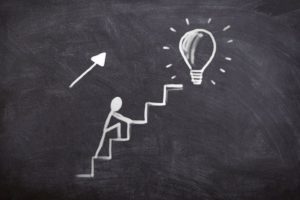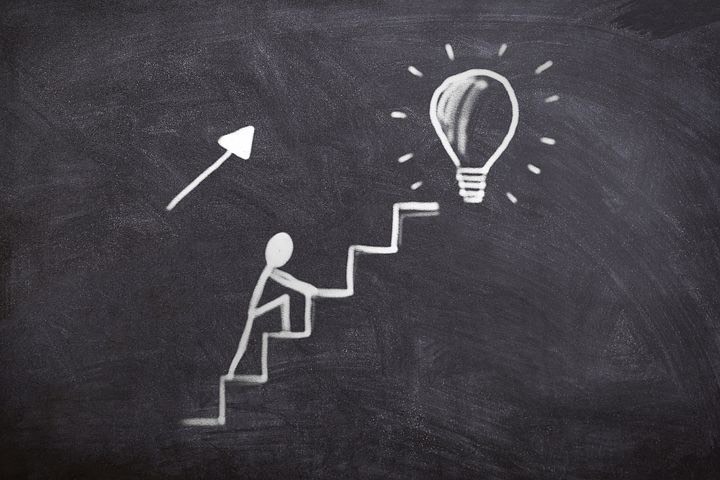There are many famous frameworks ranging from McKinsey’s Three Horizons Model to the various types of innovation (e.g. disruptive, radical, incremental, etc.) and many more. Conceptually, they are all great. However, from a real life perspective, they tend to be more descriptive and less prescriptive. This means it’s helpful if all you want to do is understand, but not as helpful if you want to actually do it.
Based on my experience, it is much more effective if we can map out the stages in a way that a company can coach, guide, and achieve innovation progress. To me, this means knowing the time ordered stages that organizations go through as they increase their innovation.
Let’s start with the basics, most people and organizations don’t need or care about innovation. What they want is to be more competitive, to execute quickly, to stay ahead of competitors, and to have alignment between their strategy and what people are working on. If you want your group or company to be forward looking, fast, efficient, effective, and adaptive – then that is what I am addressing here.
So how do organizations get there? They do it by learning to innovate with small projects and then they learn how to replicate that culture and mindset in a more systematic way. Each of these is a stage that must be learned. Let’s call these Innovation Engineering Capability Levels – or maybe just practical levels for innovation.
Practical Levels of Innovation:
- Stage 1 – Ad Hoc: This means ad hoc or random teams and individuals are making innovation happen. This means that a few innovative individuals or a few small teams are heroes. They just seem to know what to do. There is no structure or guiding culture that supports them.
- Stage 2 – Story testing for resource allocation: This is the first step to becoming programmatic across the organization. For every group that is working on a great idea, there are others that are often working towards poor ideas that are not as helpful or aligned. To fix this, the organization needs to first learn what a good innovation story sounds like and the organization then needs to be able to test each story narrative (examples range from SRI’s Need, Approach, Benefit, Competition model to Amazon’s 6 page plan). That way, the resources that are being used towards poor stories can be reallocated towards great stories.
- Stage 3 – Strategic but slow execution: To get to this next stage, the story narratives that are being developed should align in a strategic way, meaning that the projects are now all pulling the organization in a common direction. However, it does not mean that all of the projects will be successful nor that they will be executed quickly.
- Stage 4 – Moderate execution and basic Innovation behavior: In this phase, the teams have learned the fundamentals of innovation-oriented mindset, behaviors, and leadership. Once this has happened, the execution of innovation projects automatically becomes more efficient.
- Stage 5 – Embed innovation culture with high performance: In this stage, people who have innovative behaviors and mindsets are able to teach each other and reinforce this within their groups. When companies are at their peak, the teams are operating in this manner. The organization has become self-adapting and self-healing, which is a wonderful state in which to operate.
What stage is your organization in? And what could you do to get it to the next stage?
This article supports the Innovation Engineering, which is a framework developed by Ikhlaq Sidhu at UC Berkeley to apply technology and create transformation by aligning human talent in an efficient, effective, and positive manner. This framework offers practical guidance for how large firms, research labs, new ventures, and even student projects can execute their innovation projects and make their ideas a reality. Interested in learning more? Check out innovation-engineering.net and read the book, Innovation Engineering.
There are many famous frameworks ranging from McKinsey’s Three Horizons Model to the various types of innovation (e.g. disruptive, radical, incremental, etc.) and many more. Conceptually, they are all great. However, from a real life perspective, they tend to be more descriptive and less prescriptive. This means it’s helpful if all you want to do is understand, but not as helpful if you want to actually do it.
Based on my experience, it is much more effective if we can map out the stages in a way that a company can coach, guide, and achieve innovation progress. To me, this means knowing the time ordered stages that organizations go through as they increase their innovation.
Let’s start with the basics, most people and organizations don’t need or care about innovation. What they want is to be more competitive, to execute quickly, to stay ahead of competitors, and to have alignment between their strategy and what people are working on. If you want your group or company to be forward looking, fast, efficient, effective, and adaptive – then that is what I am addressing here.
So how do organizations get there? They do it by learning to innovate with small projects and then they learn how to replicate that culture and mindset in a more systematic way. Each of these is a stage that must be learned. Let’s call these Innovation Engineering Capability Levels – or maybe just practical levels for innovation.
Practical Levels of Innovation:
- Stage 1 – Ad Hoc: This means ad hoc or random teams and individuals are making innovation happen. This means that a few innovative individuals or a few small teams are heroes. They just seem to know what to do. There is no structure or guiding culture that supports them.
- Stage 2 – Story testing for resource allocation: This is the first step to becoming programmatic across the organization. For every group that is working on a great idea, there are others that are often working towards poor ideas that are not as helpful or aligned. To fix this, the organization needs to first learn what a good innovation story sounds like and the organization then needs to be able to test each story narrative (examples range from SRI’s Need, Approach, Benefit, Competition model to Amazon’s 6 page plan). That way, the resources that are being used towards poor stories can be reallocated towards great stories.
- Stage 3 – Strategic but slow execution: To get to this next stage, the story narratives that are being developed should align in a strategic way, meaning that the projects are now all pulling the organization in a common direction. However, it does not mean that all of the projects will be successful nor that they will be executed quickly.
- Stage 4 – Moderate execution and basic Innovation behavior: In this phase, the teams have learned the fundamentals of innovation-oriented mindset, behaviors, and leadership. Once this has happened, the execution of innovation projects automatically becomes more efficient.
- Stage 5 – Embed innovation culture with high performance: In this stage, people who have innovative behaviors and mindsets are able to teach each other and reinforce this within their groups. When companies are at their peak, the teams are operating in this manner. The organization has become self-adapting and self-healing, which is a wonderful state in which to operate.
What stage is your organization in? And what could you do to get it to the next stage?
This article supports the Innovation Engineering, which is a framework developed by Ikhlaq Sidhu at UC Berkeley to apply technology and create transformation by aligning human talent in an efficient, effective, and positive manner. This framework offers practical guidance for how large firms, research labs, new ventures, and even student projects can execute their innovation projects and make their ideas a reality. Interested in learning more? Check out innovation-engineering.net and read the book, Innovation Engineering.


